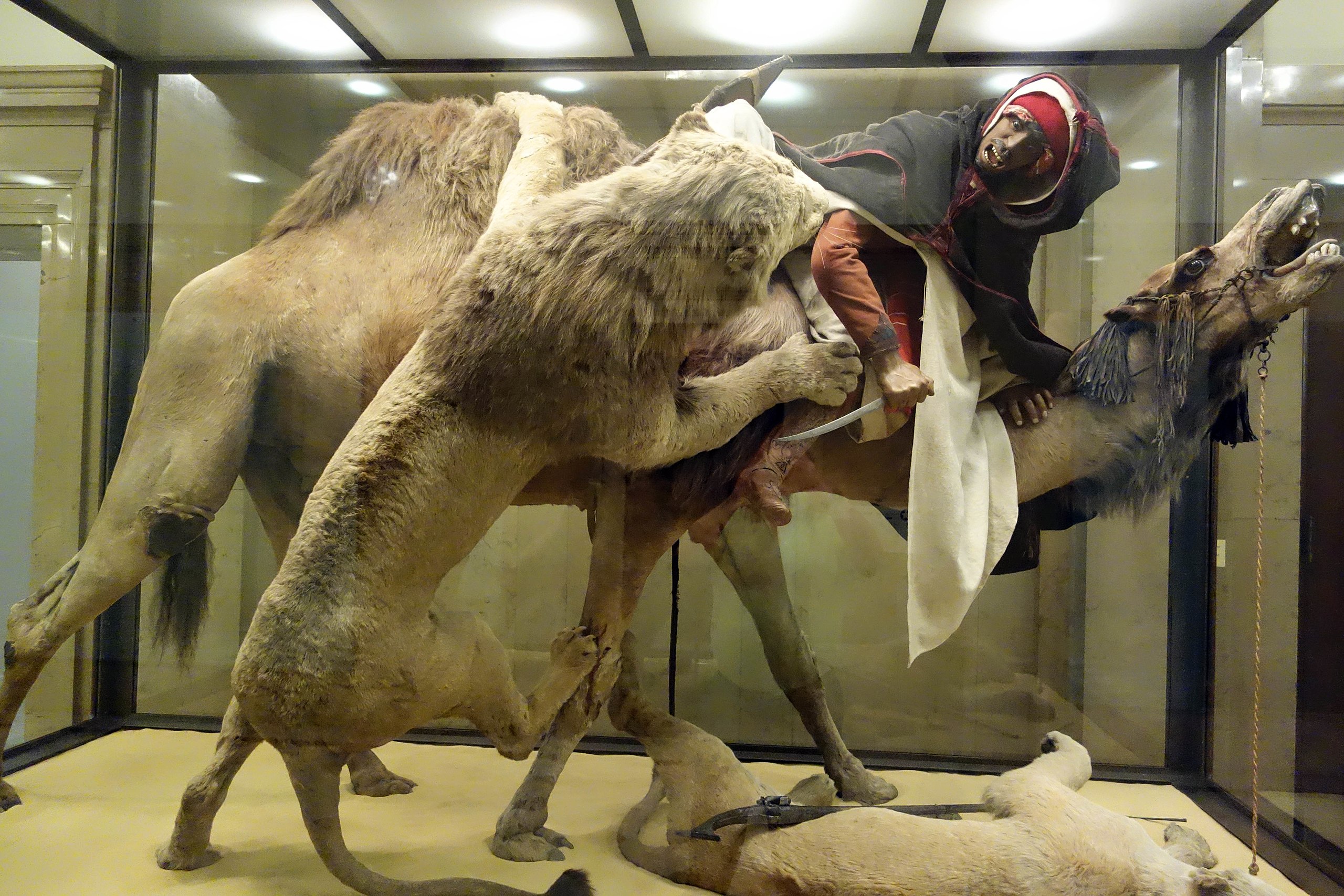
Boy, as a kid, would I have loved the diorama “Lion Attacking a Dromedary” at The Carnegie Museum of Natural History in Pittsburgh! Things like that—by “like that” I mean cool, stimulating exhibits that fired my curiosity—got me interested in all sorts of subjects growing up: paleontology, zoology, history. The creation of French naturalist and taxidermist Edouard Verreaux and his brother was made for the Paris Exposition of 1867 and has been at the Pittsburgh museum since 1899. I wish it had been lodged at the Peabody Museum in Cambridge, Mass., where I used to spend long, leisurely Saturdays with my best friend, Peter Bena.
But now, fully in the grip of what I call “The Great Stupid,” the Carnegie Museum’s interim director says the exhibit is being “reconsidered,” because the exciting scene has disturbed “some.” After all, it depicts violence against a man described as an Arab courier. Also, the victim’s garb has been determined to be “derived from” at least five separate North African cultures. So that’s bad. I’m not sure why, but it’s bad. I’m sure PETA thinks the scene encourages cruelty to camels.
To make things worse for the exhibit, recent X-rays of the lions’ victim showed that the 1860s-era taxidermy was performed with real human bones from an unknown person. The director notes that the museum’s ethics policy requires that the use of any human remains “respect the person’s cultural traditions” and only be done with permission “of the people whose remains are displayed.” He also tut-tuts that the museum has no other dioramas that include humans, “and certainly no white European humans being attacked by animals.”
And wait! There’s more! The scene depicts a male lion hunting, though it much more common for female lions do the hunting.
Ethics verdict: There is nothing unethical about the diorama.
The complaints listed by the director are contrived and silly. To begin with, the diorama itself has historical significance because of its origins, so the niggling about the authenticity of, for example, the currier’s costume is irrelevant. The director’s statement that “no white European humans being attacked by animals” are shown in the museum is so idiotic that no one should take this political correctness junkie seriously, ideally for the rest of his irritating life. Is his contention that there should be a diorama showing every race and ethnic group being attacked by lions, or else the museum is being discriminatory? Oh, probably. I sometimes wonder if all humans should have devices installed in their heads that cause them to explode when they think anything this stupid, for the protection of society.
As for the museum’s ethics rule regarding human remains, obviously that should only apply to exhibits added to the museum after the rule was promulgated. There is no way to get consent from an unknown individual who lived over a 150 years ago. (“Pardon me, sir, would you please sign this consent form allowing you to be shown as an Arab being attacked by lions for the foreseeable future?” ) As for the—what do we call it, dead lion sexism?—imaginary problem of a male lion attacking in the scene rather than a female lion, there is this rather famous precedent, memorialized in another, presumably less hysterical museum, the Field Museum in Chicago, with this exhibit:

Yes, the title to this post was a trick. The diorama is neither icky nor unethical, but this episode is just one more example of the perpetually offended making life a little less interesting, dynamic and stimulating in their own petty, crummy ways, every day of their lives.
This is just a small thing. Have you looked at the list of all the art currently displayed in the Capitol Rotunda?
https://en.wikipedia.org/wiki/United_States_Capitol_rotunda#:~:text=Historical%20paintings%20%20%20%20Painting%20%20,a%20s%20…%20%204%20more%20rows%20
Four of the huge paintings are from the Revolutionary era. Four more are from the early exploration of America, including the landing of Columbus, De Soto’s discovery of the Mississippi (of course he didn’t discover anything, same as Columbus), and the baptism of Pocahontas. And that historical frieze? It’s got to go. I think it may be time for the raising of a new rotunda, with entirely new artwork.
I’m sensitive to the human remains argument.
I don’t even think we should be gawking at mummies 4000 years old.
But the rest of the arguments? Silly.
Yeah, I agree. I don’t think it’s in great taste to exhume dead people, nomatter how rich, famous or ostentatious their remains and put them in front of people as show. Why don’t we dig up all of America’s presidents and assemble their skellingtons while we’re at it?
Lenin’s still on display!
And Jeremy Bentham! But he consented!
Just his head. The rest is fake.
Oddly, these objections didn’t surface (except on Ethics Alarms and few other places) when the Chinese exhibit of artistically posed and exposed cadavers hit the U.S. art museums a while back.
God, that was CREEPY. Who would have wanted to go see those shows?
Body Worlds is still happening and still gross. I saw an ad for it just the other day.
Couldn’t remember the name. Thanks. Ugh.
There are at least 12 body exhibits going on around the world. The one in Idaho features animals. That will probably cause the next uproar.
I’ve always refused to go. Yuck.
This story epitomizes political correctness and wokeness. Here’s a good antidote: https://elmoudjaweb.com/an-ex-liberal-reluctantly-supports-trump-jaweb/
Just one of many highlights, but terribly on point as a response to the Authentic Frontier Gibberish gushing from Pittsburgh: ‘I ask Mr. Siegel to define political correctness: “The inability to speak the truth about the obvious.”’
I wish I were smart enough to have composed that definition. Mr. Siegel is evidently a modern day Samuel Johnson.
The Field Museum is just as bad.
https://www.fieldmuseum.org/exhibitions/looking-ourselves-rethinking-sculptures-malvina-hoffman
I would guess that white Europeans comprise the largest single group of persons whose remains are on display somewhere. The Paris catacombs alone might clinch that, never mind all the displays in museums and monesteries throughout Europe.
As a child, one of my favorite displays was an in-situ mass grave at an Indian mound-bulding society site. Those skeletons are gone now, of course. One of my son’s favorites is a carved frieze of a Babylonian lion hunt housed in the British Museum.
It’s still there, along with Cashel Man (He’s Irish, so ethnic minority?)…for now.
For whatever reasons, people are fascinated by the sometimes macabre remains of both humans and animals, and their violent histories. Interest fosters learning. But yeah, water down, grey out, mask and hide everything in a vain attempt to avoid any and all triggers and microagressions. That’ll work; we can save the cost of all those empty museums.
“The scene depicts a male lion hunting, though it much more common for female lions do the hunting.”
That’s a dead female at bottom right of the picture. The Arab ain’t no wimp.
I think this vignette is from a fairly popular topic for 19th Century art. Mrs. OB and I were penniless when I was teaching at a parochial grade school on North Miami Beach in the mid-seventies. Picture Hyman Roth’s house in “The Godfather Part Two.” There were a number of wealthy parents, including a New Jersey based mafioso. One of the fathers (of a kid in my seventh grade class) was an art dealer and put on an auction in the new (very elegant) parish hall to raise some money for the parish. Mrs. OB and I attended and bid on the smallest, least expensive item up for sale… and won, with the opening bid of $150.00. Maybe the other attendees felt bad for us and didn’t bid. The piece was an etching by Delacroix. Just a page taken from a book and framed, doubtless, After we’d been declared the lucky winners, I asked Mrs. OB to translate the French title of the piece: The answer: “Lion Eating the Heart of an Arab.”
Or maybe the camel. Those things are vicious.
Jack,
Cases like this demonstrate there is no end to the censorship slope. Originally, we were told that Confederate statues belonged only in museums, where they could be given context. Except, as recent history has demonstrated, even museums are no longer safe. Come to think of it, the library has all sorts of books with complicated social and historical themes …
We all know that animals are vegetarians by nature. It’s only the bad influence of humans that drive them to be carnivores. On the other hand my kids would have loved this display. Also, who is to say the person riding the camel didn’t pick-up bits and pieces of clothing on his travels. You know, cultural appropriation.
Maybe he was an anthropologist?